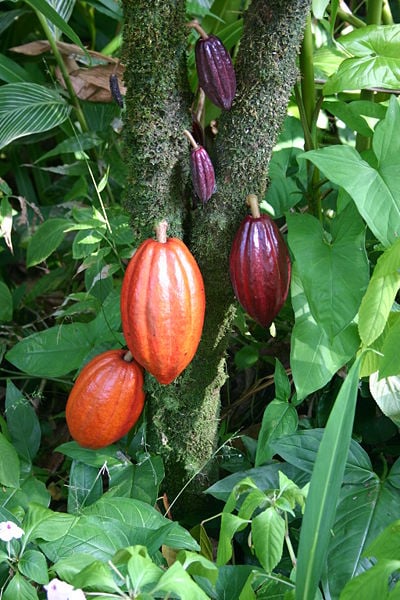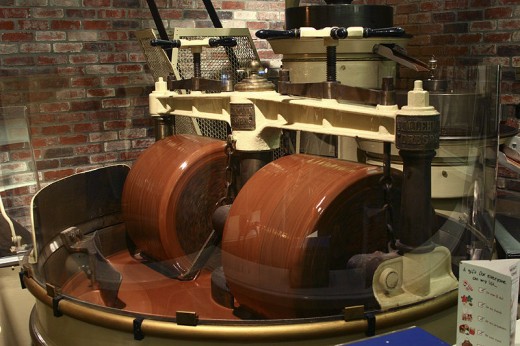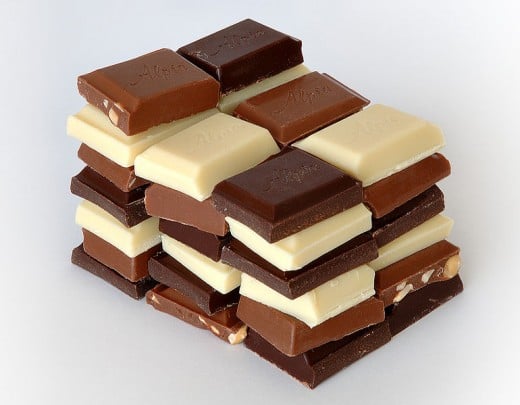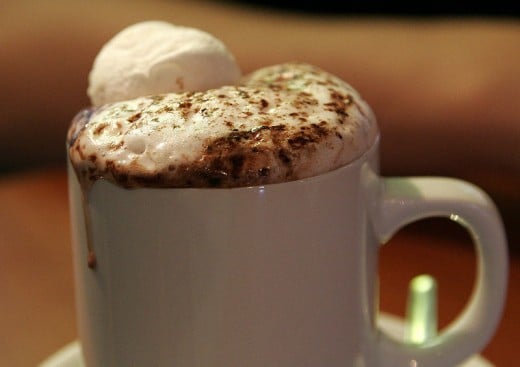What are the Benefits of Chocolate
Where did Chocolate Originate
There is no doubt whatever that chocolate is a Mesoamerican food grown for at least 3,000 years. Its earliest use can be found in what is now Mexico and Central & South America. The earliest established use of chocolate was found in an archeological dig in Honduras dating to about 1,400 BCE. The vessel containing the chocolate also included the white pulp that surrounds the seed. Due to the high sugar content of the pulp it may have been an alcoholic drink using these sugars for fermentation.
The word chocolate is derived from the Nahuatl word xocoatl. Xocoatl was a Mayan chocolate drink flavored with vanilla, chili pepper and annatto. From linguistic research it appears that xocoatl means "warm liquid."
In later times the Aztec used cocoa pods as currency. There is written evidence, for example, that a fresh turkey was worth 100 cocoa pods and an avocado three. As the Aztec conquered surrounding lands they often levied taxes, or tributes, based on cocoa pods.
When the Spanish conquistadors conquered the area they took the cocoa back to Spain with them; initially it wasn't very popular. But as time progressed Spanish cooks found new was to use cocoa and its popularity increased.
Oddly, in both Mesoamerica and Spain, chocolate was a drink and it was a drink for the rich an influential. Within the next century chocolate (cocoa) became popular in all of Europe, but again only among the rich and influential.
In England it was different, anyone with money could purchase chocolate and in that way the English may have had a large hand in popularizing it with the the general public.
It wasn't until 1847 when Joseph Fry & Son discovered a way to mix
some of the cocoa butter back into the the cocoa powder. They also added sugar to this paste and found that they could mold the result into chocolate bars.


Health Benefits of Chocolate
Moderate amounts of chocolate are associated with benefits to the circulatory system as well as potential anti-cancer properties. It is also a known brain stimulator, cough preventive, and has antidiarrheal effects.
A substance in cocoa called epicatechin is known to improve circulation. Cocoa also has antioxidant properties. The primary fat in chocolate is called stearic acid. Stearic acid does not raise LDL cholesterol levels unlike most other food-borne fats. Some studies have shown a reduced risk of heart attack due to consuming chocolate and a Swedish study found that patients who at moderate amounts of chocolate two or three times a week experienced heart attack three times less often than a control group who did not.
Another study has shown that chocolate milk is a superior drink for muscle recovery compared to drinks prepared for this specific use, with fewer calories.
Research has also shown that the flavonols in chocolate can help with diabetes and dementia. Another substance in chocolate, theobromine, has been found to be more effective than codeine in relieving cough.
Where theobromine is good for humans it is quite deadly to animals such as horses, cats, dogs, rodents and parrots. This is because these animals, unlike humans, cannot metabolize theobromine.
Interestingly, theorbromine is known in the horse racing world as a powerful equine stimulant and its use is banned.
Beneficial Elements in Choclate
Chocolate contains anadamide, caffeine (in small amounts), dopamine, oxalic acid, stearic acid, serotonin and tryptophan.
Anandamide has a number of benefits. It helps with the relief of pain, is a hunger inducer, enhances the feeling of pleasure and plays a role in balance.
Serotonin helps regulate appetite, sleep, mood, muscle contraction, as well as memory and learning.
Tryptophan is often touted as a sleep aid.


Chocolate Manufacture
The Many Steps to Chocolate
Like coffee, the chocolate we eat and drink goes through many steps to get from the tree to the store shelf.
- The pods are picked at the height of ripeness
- The pods are opened and the pulp and seed are separated.
- The beans are fermented and sun-dried.
- The beans are then cleaned, dried, and roasted.
- The beans are then broken and the germ and bran are removed.
- The nibs are separated from the bran.
- The result is then milled (ground) into a paste called chocolate liquor.
- The liquid (cacao butter) and powder are separated.
- The cacao is then split off into two processes for creation of cacao powder and chocolate.
If the end result is to be powdered (cacao powder) then the following steps occur. These steps define the cacao as cacao powder.
- An alkali is added to the help separate the powder from the liquid.
- Fat is pressed out of the cacao.
- At this point the powder and cacao fat are separated.
- The powder if further ground to make it consistent.
- Finally the powder is sifted.
If the final result is chocolate then the following steps occur.
- Sugar, milk (optional), and cocoa butter (from step 2 above) is added.
- The chocolate is mixed at precise temperatures and times.
- The chocolate is then "conched" which means it is further ground at precise temperatures and set times to create a smooth consistent texture.
- Finally the chocolate is "tempered" meaning it is heated to 113° F and then allowed to cool slowly to a set temperature and then kept there until it solidifies. This tempering causes all the crystalline forms of chocolate to melt and then keeps those crystals from reforming. The white "blossom" occurs if this is not done properly of if the chocolate is heated and re-chilled improperly.
- The result is then molded into bars, etc. or used as a viscous liquid for coating other edible items.
Conching and tempering determine both the smoothness and melting point of chocolate. Perfectly tempered chocolate will not melt until it reaches 93° F. This means that it can be carried around in purse or pocket with no fear of melting. Once eaten the chocolate will "melt in the mouth" of the consumer. Human body temperature is 4° to 5° F higher than the storage temperature of chocolate. This makes chocolate unique among foods.
Chocolate Facts
- Aztec
emperor Montezuma drank 50 golden goblets of xocoatl every day.
- West Africa provide seventy percent (70%) of all cacao beans.
- Hans Sloane (1660-1753) came up
with the idea of mixing the bitter chocolate beverage with milk to
improve its taste. He then patented it.
- Columbus introduced cacao to Spain (and Europe) on his fourth voyage in 1502.
- Milton S. Hershey made his fortune in caramel. He sold this business in 1900 for $1 million and started making milk chocolate generating an even larger fortune.
- Americans consume 10 to 12 pounds of chocolate a year. Britons consume twice that.
- As of 2008 chocolate makers used forty (40%) percent of the world's almonds and twenty (20%) percent of the world's peanuts.
- U.S. chocolate manufacturers use about three and a half million pounds of whole milk every day to make milk chocolate.
- Chocolate syrup was used as blood in the famous shower scene in the Alfred Hitchcock movie 'Psycho'.
- The Cacao tree only thrives in latitudes no more than 20° north or south of the equator.
- Hawaii is the only state in the fifty United States that can grow cacao.
- The fruit of the Cacao tree grow directly from the trunk. Each fruit contains contains 20 to 50 seeds or beans. It
takes about 400 beans (eight to twenty pods) to make a pound of chocolate.
Choosing and Storing Chocolate
Choosing Chocolate
This is really a matter of taste.
When using the word "chocolate" (from the manufacturing description above) we are referring to the bars and syrups not the powder. Chocolate, by definition, is a combination of cacao powder and cacao fat (butter); the powder is cacao without the butter or fat.
The "best for you chocolate" is that which contains the most cacao powder. Because chocolate has such a strong flavor it can be drastically diluted (with sugar, milk, and other additives) and still have it's characteristic taste. For that reason it's best to know which form has the highest cacao solids content and therefore the best health benefits. So, of all the varieties of chocolate available milk-chocolate has the least amount of cacao powder and bittersweet the most at up to 50% by volume.
"White chocolate," isn't really chocolate as its simply the cacao butter without the cacao solids.
Storing Chocolate
Chocolate bars should keep for about eight months if stored in a dark cool place.
If exposed to too much heat, chocolate will take on an oily sheen on the surface. This is the result of the components of the bar separating and rising to the surface. It does not affect the taste of the chocolate.
If the chocolate has a white "bloom" on it, the bar has been exposed to heat and then re-chilled at the wrong temperature or too rapidly. Again, the flavor will not be affected, but the bar may become more brittle and less creamy.
Less Than Usual Chocolate Receipes
Both these recipes exclude milk. Enjoy!
No Milk Chocolate Pie
Ingredients
- 2 cups chocolate chips, bittersweet or dark
- 1/3 cup coffee liqueur
- 1 block silken tofu
- 1 teaspoon vanilla extract
- 1 tablespoon honey
- 1 prepared chocolate wafer crust
Directions NO BAKING REQUIRED
- Place a small metal bowl over a saucepan with simmering water. Melt the chocolate and coffee liqueur in the bowl. Stir in vanilla.
- Combine the tofu, chocolate mixture, and honey in the blender. Liquefy until smooth.
- Pour the filling into the crust and refrigerate for 2 hours, or until the filling is set.
Chocolate Sorbet
Ingredients
- 1 Cup sugar
- 1/2 Cup very good cocoa powder
- 1/4 teaspoon pure vanilla extract
- 1/8 teaspoon ground cinnamon
- 1/8 teaspoon kosher salt
- 2 Cups water
- 1/4 Cup brewed espresso
- 11/2 Tablespoons coffee liqueur
Directions
- In a large saucepan, mix the sugar, cocoa powder, vanilla, cinnamon,
and salt.
- Stir in 2 Cups water and the espresso.
- Cook over low heat until the ingredients are dissolved.
- Remove from heat and stir in the coffee
liqueur.
- Transfer to plastic containers and refrigerate until very cold.
- Finish the mixture in an ice cream freezer according to the
manufacturer's directions.
- The sorbet will still be soft; place it in a plastic container and freeze for 1 hour or overnight, until firm enough to scoop.










